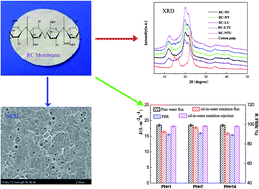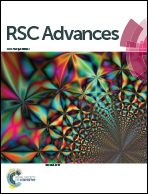Preparation and characterization of the tolerance to acid/alkaline and anti-oil-fouling of regenerated cellulose membranes for oil–water separation
Abstract
Novel regenerated cellulose (RC) membranes were fabricated using an immersion precipitation phase inversion method from five non-derivative solvents (NaOH/urea/H2O, NaOH/thiourea/H2O, LiOH/urea/H2O, NaOH/urea/thiourea/H2O and LiOH/urea/thiourea/H2O) for oil–water separation. The prepared RC membranes exhibited a similar asymmetric and reticulated pore structure, with a pore diameter ranging from 12.77 to 17.09 nm, which is similar to typical ultrafiltration membranes. The biggest pore diameter was obtained using a NaOH/urea/H2O solvent and the best mechanical properties were obtained using a LiOH/urea/H2O solvent, which indicated that by using different mixed solvents, different pore sizes and mechanical properties can be obtained for fabricated cellulose membranes. Measurements of the flux and the rejection using edible oil/water in this study showed that our prepared membranes possessed excellent oil retention ratios of up to 98%; meanwhile the water flux recovery ratios were around 90% through simple water flushing. Besides, after immersion in strong acid/alkaline solution for a week, the pure water flux (J), dimensions and weight showed no obvious change, and there was no change in filtration performance at room temperature with a pH from 1 to 14, indicating the advantage of high tolerance to acid/alkaline.


 Please wait while we load your content...
Please wait while we load your content...